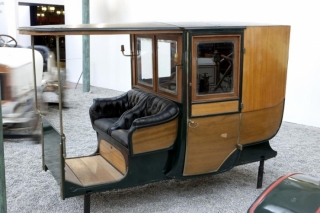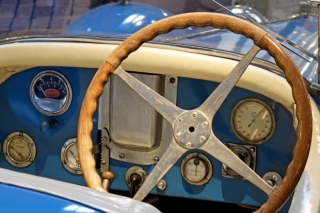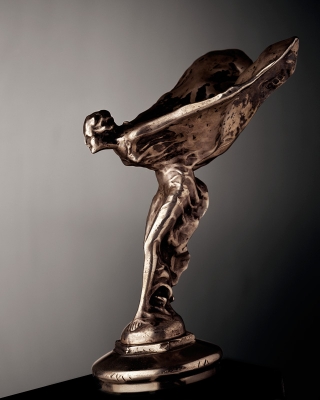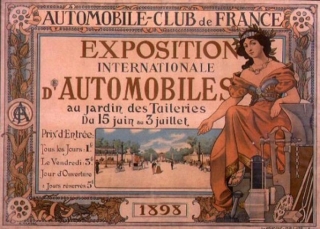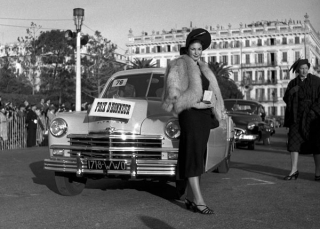Did you know?
Le chauffeur
On the steam railways, the engine had an “engineer” (engine driver) and a fireman (stoker), called a chauffeur in French. The driver was responsible for engine operation and the chauffeur looked after the fire, being responsible for maintaining sufficient pressure in the boiler. The first self-powered road vehicles were steam powered and their drivers also had to heat the water in the boiler. So, they were called chauffeurs in French. This habit persisted when petrol engines came in. Gradually, chauffeur came to be used only for professional drivers, as in the English borrowing for personal drivers; in French it is also used for the drivers of taxis, lorries and buses. In France non-professionals are now just called conducteurs (drivers), except the bad ones: they’re called chauffards (road hogs)!
Bodywork styles
The bodywork of the first cars was directly based on that of horse-drawn carriages. They were made using the same techniques, with the same styles, and usually by the same craftsmen. Thus, the first cars were vis-à-vis, phaeton, hackney or brougham carriages. But soon the specifics of motor car technology, safety requirements and the need for better streamlining led manufacturers to invent new forms. The bonnet appeared and became increasingly large. Wood was replaced by steel. Sharp angles gave way to rounded forms and smooth lines. Despite all this, the names of horse-drawn carriages continued to be used, especially in French: coach (a word borrowed from the English for a two-door four-seat covered carriage), coupé (a two-door two-seat saloon), roadster (a two-seat convertible), cabriolet (a convertible), berline (a four-seat saloon with four side windows) or limousine (a long saloon with six side windows).
Windscreen wipers
Windscreen wipers appeared at almost the same time as the windscreen itself. Initially they consisted of a single vertical scraper held in place by an inverted U-shape straddling the upper edge of the windscreen. The driver slid it manually. When saloon cars appeared, the scraper was connected to a crank handle that the driver turned first one way then the other. However, the driver still had to drive with only one hand or not see anything! During the 1920s the first automatic windscreen wipers that were linked to the engine appeared. Perversely, however, their wiping speed tended to reduce with engine speed: the faster you drove the slower they wiped!
In 1924, Bosch developed electric wipers and these were gradually improved by the addition of variable speeds, screen washers and flexible blade holders. Now, at the dawn of the third millennium, the dream is to dispense with them entirely by using special coatings on the glass itself.
Left-hand drive, right-hand drive
Before the motor car, coaches in most countries drove on the right. But drivers sat on the right of their bench. In this position, they could more easily monitor the verge. It let them pull closer to the edge of the road when crossing another vehicle, and see any potholes or bumps, which are more common there. Also, this driver position meant that they could open the doors for passengers getting off kerbside without having to walk around the vehicle. For this reason, the steering wheel was installed on the right on the first motor cars.
In 1919, Citroen was the first manufacturer in Europe to place the steering wheel on the left, explaining that this made it easier to overtake slower vehicles. Everyone followed suit, except a few luxury-car manufacturers like Salmson and Delage.
“Taxis de la Marne”
At the beginning of September 1914, the German army was so close to Paris that only a huge, rapid counter-offensive could save the city. Reinforcements had to be sent to the front as quickly as possible. Troops set off by train and in army vehicles, but that wasn't enough. General Gallieni, military governor of Paris, then had the idea of commandeering all the capital’s taxis. The old Renaults gathered on the Esplanade des Invalides and an initial convoy of 250 taxis set off on the night of 6th September. But this was not enough and the police stopped all the taxis in the city, shouting: “Commandeered, return to your depots!”. Approximately 1000 taxis finally took part in the operation which ended the following night. Some vehicles broke down and others lost their way but the “Taxis de la Marne” as history has called them, succeeded in transporting five infantry battalions – 4000 men. The element of surprise worked and the Battle of the Marne pushed the Germans away from the capital.
La « Flying Lady » de Rolls-Royce
Buyers had a free choice of radiator caps for the first Rolls-Royces. However, the manufacturer was concerned by the poor taste of some and decided to create its own which would be worthy of the Rolls. Sculptor Charles Sykes designed the “Spirit of Ecstasy” (also called the “Flying Lady”). The sense of take off, billowing robes and clean lines evoke speed and silence, grace and power.
Designed like a ship’s figurehead, the work was a resounding success: in 1920 it won the Gold Medal for the best motor car mascot in an international competition.
It remains an optional extra. For example, an American meat-industry magnate chose a silver sausage as his emblem. But such deviations are rare and the silver lady remains the most famous car mascot in the world. So much so that theft has been a problem. To solve this, the mascot has been made retractable: if touched, it instantly disappears into the bonnet, which also brings it into line with the latest safety standards.
Peugeot and 3 figure numbering
 In 1929, the 201 started the pattern of 3 figure numbers. The central zero is surrounded by an initial number indicating the size and a third number in the chronological series. The zero corresponded with the hole for the starting handle.
In 1929, the 201 started the pattern of 3 figure numbers. The central zero is surrounded by an initial number indicating the size and a third number in the chronological series. The zero corresponded with the hole for the starting handle.
Horsepower and fiscal horsepower
When the steam engine was invented, a unit of for measuring power was developed. It was based on what was already known: the work a horse could perform. A horse can lift 75 kg over 1 metre in one second. Thus, one horsepower equals 75 kg-metres per second.
As the French Government was very keen to tax motor cars, it defined fiscal categories based on power. Power is primarily a function of the cylinder volume. Unlike the actual power, which can vary depending on engine settings, age and wear, cylinder volume is easily checked and unchanging. So the Government set a mathematical ratio: one fiscal horsepower equalled one sixth of a litre of cylinder capacity.
The Paris Motor Show
The first Paris Motor Show was organised in 1898 on the Esplanade des Invalides in Paris. The 269 exhibitors had to prove that their vehicles were running well by making a return trip to Versailles. The show was a huge popular success. In 1901, it moved to the Grand Palais and became a Paris institution. It is a place where reputations are made and lost and is a key event for manufacturers. The future of a new model is often largely decided there.
Before the opening day, secrets are closely guarded. Specialist journalists try to unveil them by tracking down prototypes on their road tests. The legal battles between Citroen and Auto-Journal, which had managed to observe the Citroen DS before its release, are still famous. The magazine won after two years of wrangling.
Car parades
Car parades, which were very fashionable in the inter-war years, had their origins in “flower floats”. In the 19th century, carts and carriages decorated with flowers and presented by maidens, paraded to the sound of fanfares. The carriages were replaced by motorcars, the flowers by chrome and the maidens by film stars and socialites. For manufacturers of luxury cars and especially for coachbuilders, winning a prize in these competitions was worth more than extensive advertising campaigns.
Seaside or spa towns such as La Baule, Vichy or Deauville provided perfect venues.
